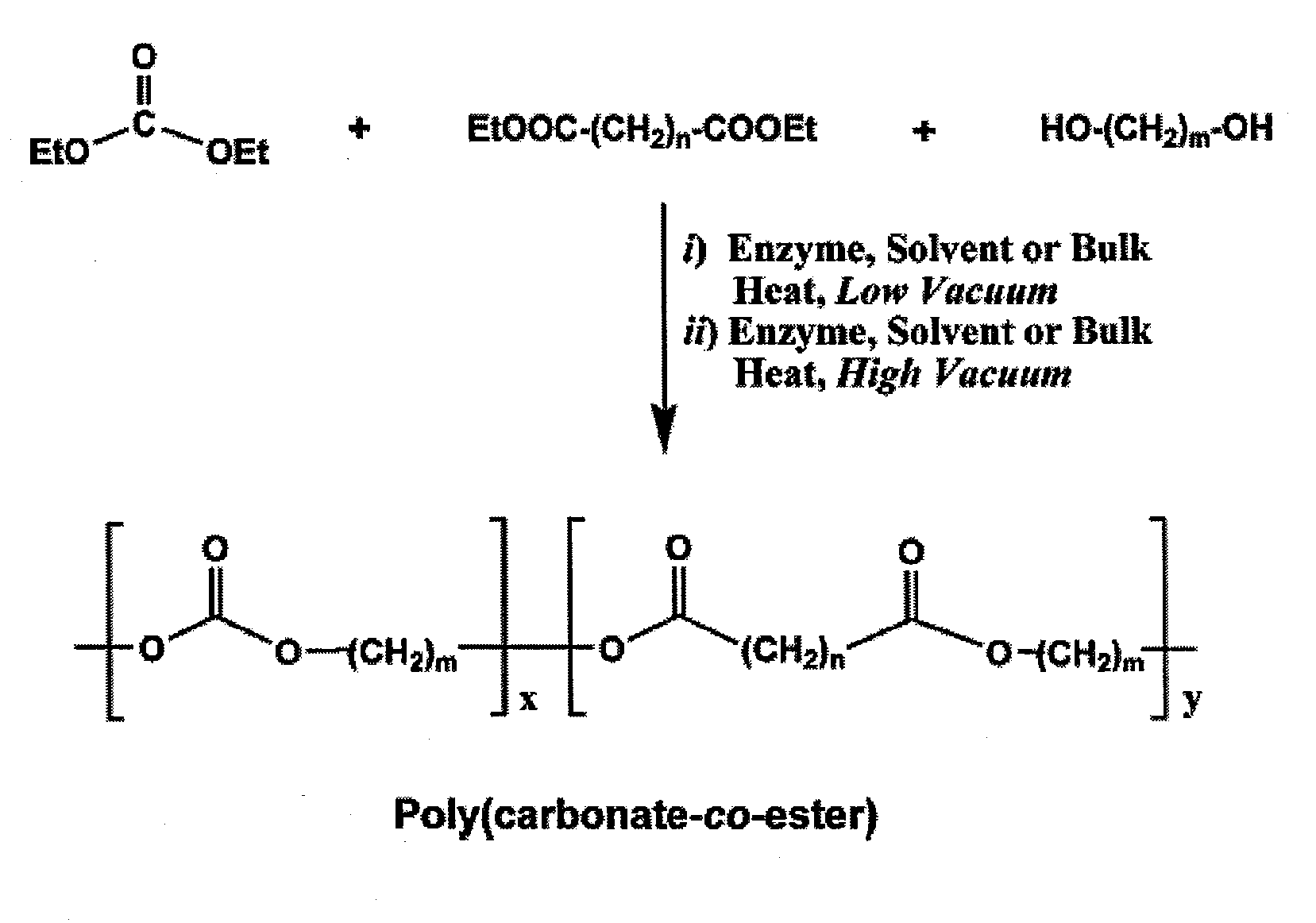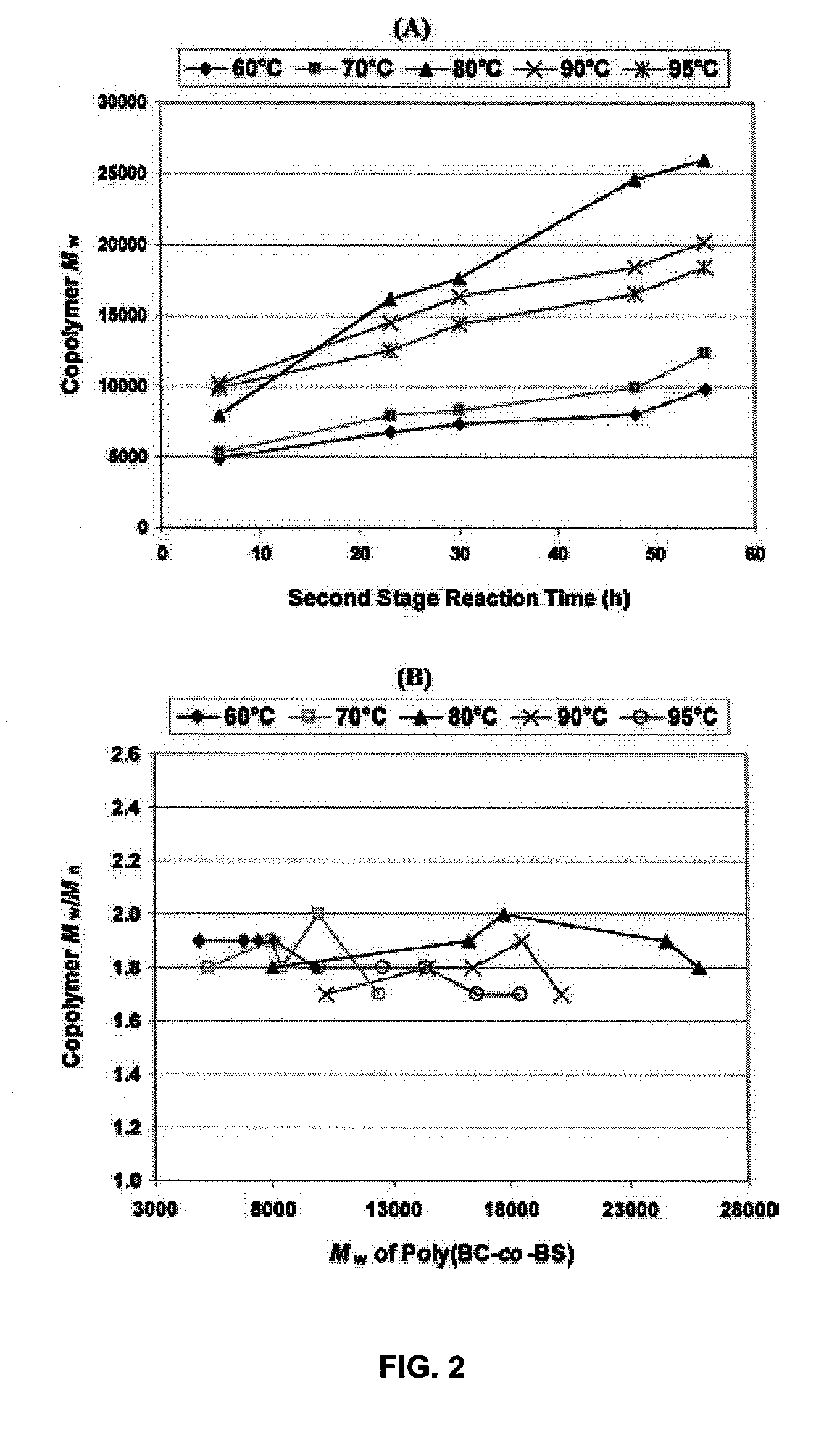Enzyme-catalyzed polycarbonate and polycarbonate ester synthesis
a technology of enzyme-catalyzed polycarbonate and ester, which is applied in the direction of fertilization, etc., can solve the problems of toxic phenol as a byproduct, low product purity, commercially impractical approach, etc., and achieve excellent control of end-group structure, high specificity of enzyme-catalysts, and low polydispersity
- Summary
- Abstract
- Description
- Claims
- Application Information
AI Technical Summary
Benefits of technology
Problems solved by technology
Method used
Image
Examples
example 1
Results and Discussion for Example 1
Two Step Process:
[0087]The two-step process for terpolymerization of DEC, aliphatic diester and diol is required because of the high volatility exhibited by DEC. The first step proceeds at a low vacuum to change monomers into non-volatile oligomers. The second step converts the oligomers to polymers under high vacuum. FIG. 1 depicts a general reaction for aliphatic poly(carbonate-co-ester) synthesis from DEC, diester and diol.
Temperature Effects
[0088]DEC, DES and BD terpolymerization were evaluated at various temperatures in diphenyl ether using a 2:1:2 molar ratio, respectively, and 10 wt % N435 in relation to the total monomer. A sample analysis of the first-stage oligomerization at 600 mmHg for 20 hours formed poly(carbonate-co-ester) oligomers with less than 2 000 via GPC analysis. NMR analysis revealed hydroxyl, ethyl ester, and ethyl carbonate end groups of the oligomers.
[0089]Chain growth versus reaction time was monitored during the second...
example 2
Results and Discussion for Example 2
[0109]Effects of Monomer Feed Ratio on Terpolymerizations of DEC with DES and BD.
[0110]Statistical analysis was conducted for synthesizing poly(BC-co-BS) with compositions other than 50:50 mol / mol BC to BS units. Experiments were conducted in diphenyl ether using 10 wt % N435 (vs to total monomer) at 80° C. Here, molar ratios of DEC / DES / BD in the monomer feed were 1.6:0.2:1, 1.2:0.4:1, 1.0:0.5:1, 0.8:0.6:1 and 0.4:0.8:1. The pressure and reaction time were 600 mmHg for 18 hours during the first stage oligomerization and 2.0 mmHg for 53 hours during the second stage polymerization.
[0111]FIG. 8 illustrates polymer chain growth vs polymerization time for copolymerizations conducted with different DES to BD feed ratios. Changes in the DES / BD ratio had no substantial effects on the polymerization rate. In all cases, Mw increased continuously throughout terpolymerization reactions. Polydisperities (Mw / Mn) of synthesized poly(BC-co-BS) copolymers ranged ...
example 3
[0130]Aliphatic polycarbonates can be biodegradable materials with potentially important medical applications. They can also be used as thermoplastic additives and as matrix materials in solid electrolytes. High molecular weight aliphatic polycarbonates are suitable for production of extrudates, films, and molded articles. Hydroxyl-terminated aliphatic polycarbonates can be useful and have been widely used in industry as building blocks to produce specialty polyurethanes and other polymeric materials. In addition, polymer membranes prepared from polyimides containing aliphatic polycarbonate segments were reported to be effective for selective separation of aromatic / saturated-hydrocarbon mixtures.
PUM
 Login to View More
Login to View More Abstract
Description
Claims
Application Information
 Login to View More
Login to View More - R&D
- Intellectual Property
- Life Sciences
- Materials
- Tech Scout
- Unparalleled Data Quality
- Higher Quality Content
- 60% Fewer Hallucinations
Browse by: Latest US Patents, China's latest patents, Technical Efficacy Thesaurus, Application Domain, Technology Topic, Popular Technical Reports.
© 2025 PatSnap. All rights reserved.Legal|Privacy policy|Modern Slavery Act Transparency Statement|Sitemap|About US| Contact US: help@patsnap.com



